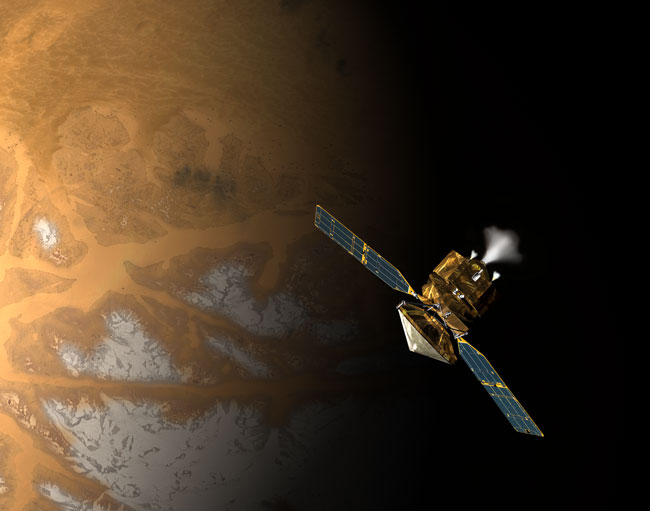Mars Reconnaissance Orbiter Blasts Off for Red Planet

Story updated at: 2:12 p.m. EDT
NASA's latest robotic mission to further unlock the mysteries of the red planet, the Mars Reconnaissance Orbiter (MRO), successfully blasted off Friday, a day after a software glitch had scrubbed its initial launch.
The MRO was carried into space on an Atlas V rocket and is now on a nearly seven-month journey to Mars.The launch had been delayed 24 hours after engineers saw an anomalous reading in the hydrogen propellant loading system on the Atlas V. There was insufficient time in the launch window to fully investigate the reading. The launch followed the successful completion Tuesday, August 9 of space shuttle Discovery's mission.
"Needless to say I'm bouncing off the walls... and ecstatic," Jim Garvin, NASA chief scientist, said shortly after MRO roared off its pad into space.
For Garvin, the MRO has strong personal resonance as he worked on the mission from "day-zero" back in May 2000 when it was but a concept initially called the "Mars Science Orbiter".
Now, with the orbiter enroute to the red planet, Garvin said the orbiter is a "scientific search engine" as well as a planetary monitoring device.
MRO was designed to be"NASA's google search engine", Garvin said, to cutdown the number of compelling places both at the surface and below the martian landscape that cry out for future exploration.
Breaking space news, the latest updates on rocket launches, skywatching events and more!
The spacecraft is carrying a hefty science payload to Mars, with six instruments designed to track Martian Weather, resolve objects on the surface the size of a kitchen table and measure the planet's composition and atmospheric structure with more detail than everbefore.
"The MRO spacecraft is manythings," Richard Zurek, the mission's project scientist at NASA's Jet Propulsion Laboratory (JPL), told SPACE.comprior to launch. "It's a weather satellite, it's a geological surveyor, and it's a scout for future missions."
"This has been the most flawless mission any of us can remember being involved in," said Kevin McNeill,MRO program manager at Lockheed Martin Space Systems during a post-launch press briefing. "Every one of the deployments on the spacecraft occurred exactly on time. It's just incredible," he said.
McNeill said that the spacecraft is in perfect health and two-way communications for command and data between Earth and MRO have been established.
"We had a flawless sendoff on Atlas. After separation, we acquired signal exactly when we had hoped [from Japan], the solar arrays deployed right on time, the high gain antenna deployed right on time...I mean it was like clockwork," McNeill noted. "We're absolutely thrilled."
The orbital spacecraft is expected to be the vanguard for two landers NASA plans to launch toward Mars in the next five years, and will identify potential landing targets. The Phoenix Lander is currently scheduled to launch in 2007 and touchdown in the planet's polar region. A large rover, the Mars Science Laboratory, is expected to launch in 2009.
The $720 million mission is divided into two parts. It should take MORE about seven months to reach Mars then another seven months or so to slowly adjust its eccentric orbit around Mars into a 250-mile (400-kilometer) high circle. The orbiter will use aerobraking to adjust its orbit, swooping in close to Mars and using the atmosphere to slow down.
During its first two years,the orbiter will help build on NASA's knowledge of the history of ice on the planet. The planet is cold and dry with large caps of frozen water at its poles. But some scientists think it was a wetter and possibly warmer place a times eons ago--conditions that might have been conducive to life.
Furthermore, while MRO was conceived as a science-driven "observatory" for the "Mars system", it is also a tool for preparing for human exploration, Garvin emphasized.
During the second phase of its mission, the orbiter will serve as a communications messenger between the robotic explorers on Mars and Earth. The reconnaissance orbiter has a powerful antenna that can transmit 10 times more data per minute than the current trio of satellites positioned around the planet--NASA's Global Surveyor and Mars Odyssey and the European Space Agency's Mars Express.
Two NASA rovers launched in 2003, Spirit and Opportunity, continue to roam the planet and may be the first robots to relay information back to Earth via the reconnaissance orbiter.
The orbiter is loaded with two cameras that will provide high-resolution images and global maps of Martian Weather, a spectrometer that will identify water-related minerals and radiometer to measure atmospheric dust. The Italian Space Agency has provided ground-penetrating radar that will peer beneath the surface of layers of rocks or ice.
"ADC" is a digital media executive and freelance journalist with ADC Strategy who previously contributed to Space.com in the arenas of human spaceflight, comets, and space exploration. As the Editorial Director of Consumer Media Imaginova Corp. he was responsible for editorial oversight of Space.com, LiveScience.com and the custom publishing of AdAstra magazine for the National Space Society. He's played a pivotal role in expanding the Consumer Media portfolio and developing custom editorial packages for major corporate sponsors. Under his watch, Space.com was awarded the 2003 Online Journalism Award for Breaking News by the Online News Association for its coverage of NASA's Columbia space shuttle disaster. His writings have most recently appeared in the Silicon Valley Business Journal.
